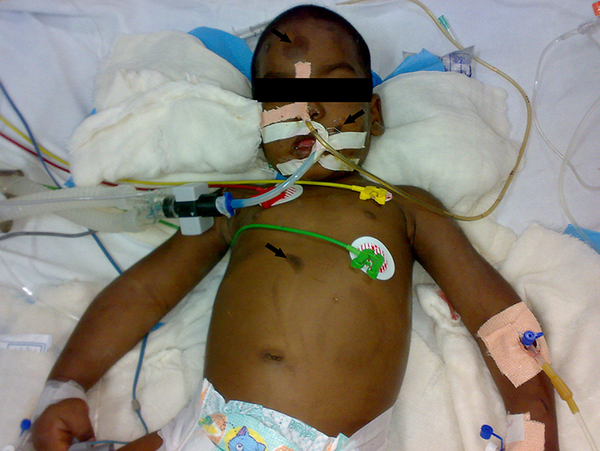Abstract
Introduction:
We report on a three-year-old child, a case of battered baby syndrome.Case Presentation:
A three-year-old female child was brought with multiple bruises, fracture of left femur and features of raised intracranial tension. The etiology was unclear at presentation. Inconsistencies in history given by the mother, a background of poverty and single parenthood, presence of multiple bruises over the body, multiple infarcts in Computerized Tomography (CT) scan, absence of external calvarial injuries and finally subdural hematoma in the autopsy report led to the diagnosis of child abuse.Conclusions:
Every clinician must be alert to the possibility of battered baby in a child with multiple injuries.Keywords
1. Introduction
We report on a three-year-old girl, a battered baby brought with intracranial bleed and multiple injuries.
2. Case Presentation
A three-year-old female child was brought by her mother with complaints of fever, vomiting and left hemiseizures followed by poor sensorium. She had allegedly sustained a fall 20 days back and had fractured her left femur for which a cast was applied, but her mother had removed it after a week without medical consultation. There was no history of bleeding manifestations, easy bruisability or family history of bleeding disorders. The child had normal development. At admission, the child was in early shock with GCS of 8/15. She had pupils of normal size, reactive to light with no changes in the fundus. She had multiple healed scars and fresh bruises all over her body (Figure 1).
Child with Multiple Bruises (arrows)

Her left thigh was swollen with abnormal mobility and crepitus. Radiograph of the left thigh revealed a displaced fracture femur. Computerized tomography scan of the head showed multiple infarcts with edema and midline shift to left. There was no evidence of sexual abuse. Persistent probing during the hospital stay revealed that the child’s father was in prison and the mother was raising the child as a single parent with no other social support. The mother attributed each injury and bruise to a different accident in the past. The child had a progressive downhill course with features of raised intracranial tension and deteriorating hemodynamic status. She succumbed to her injuries on day eleven of hospital admission. Her autopsy revealed diffuse subdural haemorrhage over the left hemisphere and congested brain with no evidence of skull fracture.
3. Discussion
The term child abuse refers to any act or failure to act that violates the rights of the child and endangers his or her optimum health, survival or development (1). Abuse can be of any of the four types; physical abuse, emotional abuse, sexual abuse and neglect. It was estimated that almost 53,000 children died worldwide in 2002 as a result of homicide and as much as 80 to 90 percent of children suffer physical punishment in their homes (2). According to an Indian study on child abuse in 2007, 69% reported physical abuse and 53% reported one or more form of sexual abuse (3).
Kempe, who coined the term 'Battered Baby' found early features of the syndrome to be bruises, bites, small burns or lacerations. He also opined that infants with failure to thrive should be investigated for neglect (4). In young infants, battered baby syndrome may masquerade as sudden infant death, differentiating the two may sometimes be an extremely difficult task (5). Cheah et al. studied 369 cases of pediatric physical abuse and reported intracranial haemorrhage in 11.4% of the study subjects; 90% of the cases were two years old or less. Subdural hemorrhage was the commonest type of bleeding, with skull fractures present in only nine cases (6). Computerized tomography image findings, which correlate well with intentional trauma to the head are convexity subdural hematoma, interhemispheric subdural hematoma, nonhemic subdural fluid (hygroma) and absence of a skull fracture (7).
Some of the risk factors for child abuse are unplanned pregnancy, low birth weight and children with physical/mental disabilities. Environmental factors associated with child abuse are single parenthood, poverty, unemployment and social isolation. Child abuse should be suspected under the following circumstances, any injury to a young infant, patterned injuries, multiple injuries at different stages of healing and unexplained serious injuries (8). In the background of the mentioned risk factors, the clinician who comes across these types of injuries 'in a child' must be alert of the possibility of child abuse.
Mandatory reporting should be made by law with penalty in case of failure to report to the police. Media should conduct talk shows and documentaries to make the public aware of the existence of child protection acts and its legality. To make physicians in general and child health consultants in particular, aware of this crime against children, the subject of child abuse should be discussed in CMEs and conferences.
References
-
1.
Nair MK. Child abuse. Indian Pediatr. 2004;41(4):319-20. [PubMed ID: 15123859].
-
2.
Pinheiro PS. Summary of the report of the independent expert for the United Nations study on violence against children, a/61/299. Advisory Council for Follow up to the UN Study on Violence Against Children; 2006. Available from: https://www.crin.org/en/docs/VAC_Summary.pdf.
-
3.
Kacker L, Varadan S, Kumar P. Study on child abuse: India. Delhi: Ministry of Women and Child Development; 2007. Available from: http://wcd.nic.in/childabuse.pdf.
-
4.
Kempe CH. Paediatric implications of the battered baby syndrome. Arch Dis Child. 1971;46(245):28-37. [PubMed ID: 5555488].
-
5.
American Academy of Pediatrics, Hymel KP, Committee on Child Abuse and Neglect, National Association of Medical Examiners. Distinguishing sudden infant death syndrome from child abuse fatalities. Pediatrics. 2006;118:421-7.
-
6.
Cheah IG, Kasim MS, Shafie HM, Khoo TH. Intracranial haemorrhage and child abuse. Ann Trop Paediatr. 1994;14(4):325-8. [PubMed ID: 7880096].
-
7.
Wells RG, Vetter C, Laud P. Intracranial hemorrhage in children younger than 3 years: prediction of intent. Arch Pediatr Adolesc Med. 2002;156(3):252-7. [PubMed ID: 11876669].
-
8.
Kellogg ND, American Academy of Pediatrics Committee on Child Abuse and Neglect. Evaluation of suspected child physical abuse. Pediatrics. 2007;119(6):1232-41. [PubMed ID: 17545397]. https://doi.org/10.1542/peds.2007-0883.